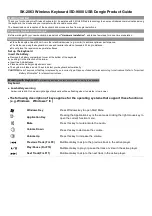
Program Mode and the Program Editor
The Program Editor—Pages
6-31
DELAY
0 to 60 seconds
ATTACK
0 to 60 seconds
RELEASE
0 to 60 seconds
Trigger
This deÞnes the control source that starts the current layerÕs ASRs. The ASR starts when the
trigger switches from off to on. If the Trigger parameter is set to ON, global ASRs will run as
soon as the program containing it is selected. Switch controls are better suited for ASR triggers
because of their binary (on/off) nature. A continuous control will trigger the ASRs when its
signal value is above its midpoint.
Mode
This parameter sets the sustain section of the ASR. The ASRÕs mode determines what the ASR
does when it Þnishes its attack section.
If the Mode parameter is set to Normal, the ASR will run directly from its attack section to its
release section (no sustain). At a setting of Repeat, the ASR will cycle through the attack and
release sections, then loop forward and cycle through again until the ASRÕs trigger switches off.
If the mode is set to Hold, the ASR maintains its position at the end of the attack section until
the ASRÕs trigger switches off. The ASR then goes into its release section.
If the ASRÕs trigger switches off before the attack section is complete, the ASR goes directly to
its release section.
Delay
When the ASRÕs trigger switches on, the ASR will start immediately if this parameter is set to
zero. Non-zero values will cause a corresponding delay between the ASR trigger and the start
of the ASR.
Attack
This deÞnes how long the ASR takes to ramp up from minimum to maximum effect on
whatever itÕs patched to.
Release
This deÞnes how long the ASR takes to fade to minimum from its maximum. If the ASRÕs
trigger switches off before the ASR has reached maximum, the ASR releases from that level.
The FUN Page
ÒFUNÓ is short for Òfunction.Ó The K2vxÕs four FUNs greatly extend the ßexibility of the
control sources. Each FUN accepts input from any two control sources, performs a selectable
function on the two input signals, and sends the result as its output, which can be assigned like
any other control source. Using the FUNs involves deÞning them on the FUN page, then
assigning one or more of them as control sources. The FUN page looks like this:
EditProg:FUN|||||||||||||||<>Layer:1/1||
||||||||||||||||||||||||||||||||||||||||
||||||
Input|a:
|Input|b:|Function:|||||||
FUN1:|
OFF|||||
|OFF||||||a+b|||||||||||||
FUN2:|OFF||||||OFF||||||a-b|||||||||||||
FUN3:|OFF||||||OFF||||||(a+b)/2|||||||||
FUN4:|
O
FF||||
|
|OFF||
|
|||a/2
+
b|||||
|
|||||
<more|
|
LFO|||
|
ASR|||
|
FUN|||
|
VTRIG|
|
more>
Содержание K2500RS
Страница 12: ...Table of Contents TOC 12...
Страница 16: ...Introduction How to use this manual 1 4...
Страница 32: ...User Interface Basics The Panel Play Feature K2vxR 3 8...
Страница 106: ...Effects Mode and the Effects Editor Configurations and Parameters 9 24...
Страница 186: ...Song Mode Recording Multi timbral Sequences via MIDI 12 52...
Страница 304: ...DSP Functions Hard Sync Functions 14 52...
Страница 394: ...Programs Setups and Keymaps K2500 ROM Keymaps 21 12...
Страница 402: ...LFOs LFO Shapes 23 4...
Страница 406: ...Note Numbers and Intonation Tables List and Description of Intonation Tables 24 4...
Страница 434: ...DSP Algorithms 26 14...
Страница 450: ...MIDI and SCSI Sample Dumps SMDI Sample Transfers 29 8...
Страница 464: ...Glossary 31 6...
Страница 490: ...K2vx Program Farm VOX K25 Appendix A 22...
Страница 494: ...K2vx Compatibility Converting programs from the K2vx to K2000 Appendix B 4...















































